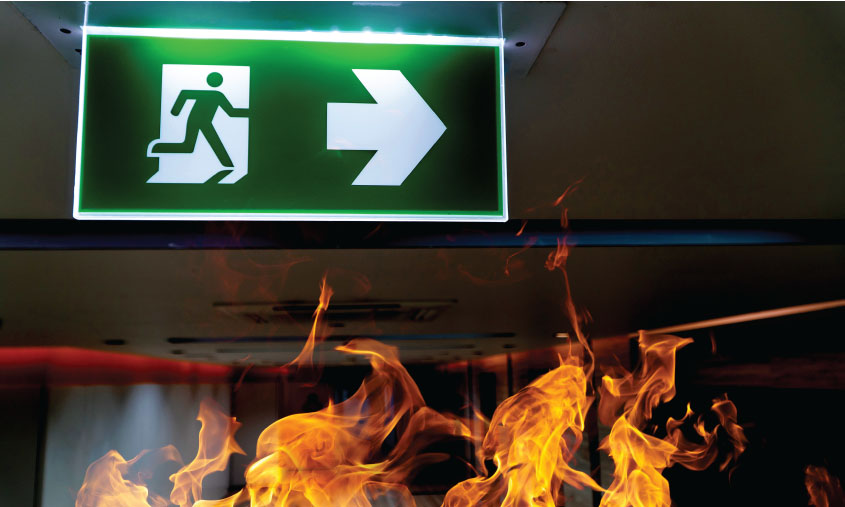
No one wants to think about a fire breaking out in their home or workplace, but the truth is that it can happen to anyone, anywhere, at any time. That's why it's important to have a fire escape plan in place and to know how to choose the best escape routes in case of an emergency.
In this blog, we'll discuss the essential factors to consider when selecting fire escape routes. So, whether you're a business owner, or just someone who wants to be prepared for the worst, join us as we explore how to choose your fire escape routes.
Why Are Fire Signs Important?
Fire safety signs are vital because they help to communicate important safety information to people in a clear and concise manner. Here are some reasons why fire safety signs are so important:
They Can Save Lives
Fire safety signs provide important information about what to do in the event of a fire, such as where to find emergency exits, fire extinguishers, and fire alarms. This information can help people evacuate a building quickly and safely, which can be critical in an emergency.
They Help Prevent Accidents
Fire safety signs can also give advanced warning about potential fire hazards, such as flammable materials or areas where smoking is prohibited. By making people aware of these hazards, fire safety signs can help prevent accidents from occurring in the first place.
They Are a Legal Requirement
In many countries, fire safety signs are a legal requirement in public buildings and workplaces. Failure to comply with these regulations can result in fines or legal action, so it is important to ensure that fire safety signs are in place where required.
They Provide Peace of Mind
Knowing that there is a plan in place in the event of a fire, fire safety signs can provide peace of mind to building occupants and employees. This can help to reduce anxiety and stress, creating a safer and more secure environment.
Overall, fire safety signs are an essential component of any fire safety plan. By providing clear and concise information, they can help to prevent accidents and save lives in the event of a fire.
What Are Fire Escape Route Requirements?
In the UK, fire escape routes must meet certain requirements to ensure the safety of building occupants in the event of a fire. The specific requirements depend on the type of building and its intended use, but here are some general guidelines:
Number of Escape Routes
There should be enough escape routes for all occupants of the building, and each escape route should be at least 1.1 metres wide.
Distance to Escape Routes
The maximum distance to an escape route from any point in the building should not exceed 18 metres.
Directional Signage
Fire exit signs should be placed alongside escape routes to guide occupants to the nearest exits.
Emergency Lighting
Emergency lighting should be installed along escape routes to ensure they remain visible in the event of a power outage.
Fire Escape Doors
In the UK, the necessary width of a fire escape door depends on the use of the building, as well as the number of occupants. However, as a general rule, fire escape doors should be at least 750mm wide. This is to allow for the safe evacuation of most occupants, particularly those with mobility impairments or those carrying large items.
Escape routes should be easily accessible and free from obstructions, with no steps or other obstacles that could impede escape.
Regular Maintenance
Escape routes should be regularly inspected and maintained to ensure they always remain clear and accessible.
While these guidelines can be applied to most establishment, it's important to note that specific requirements may vary depending on the building's size, use, and other factors. Building owners and managers should consult with local authorities and fire safety experts to ensure that their escape routes meet all necessary requirements.
How Do I Ensure My Fire Safety Signs Are Always Kept Accessible?
To ensure that fire safety signs are always kept accessible, here are some steps you can take:
- Regularly inspect and maintain signs: Conduct regular inspections of all fire safety signs to ensure they are in good condition, legible, and properly illuminated. Replace any damaged or faded signs promptly.
- Keep clear of obstructions: Make sure that fire safety signs are not obstructed by furniture, equipment, or other objects. Always keep the areas around signs clear and unobstructed.
- Train staff on the importance of accessibility: Train all staff on the importance of always keeping fire safety signs accessible. Encourage staff to report any issues with signs or obstructions promptly.
- Develop an inspection and maintenance plan: Develop a plan for regular inspection and maintenance of fire safety signs and assign responsibility to specific individuals or departments. Include regular checks of all signs to ensure they are properly located, visible, and accessible.
By taking these steps, you can help ensure that fire safety signs are always accessible and in good condition, which can help keep your building and its occupants safe in the event of a fire.
Get Peace of Mind with Label Source
Here at Label Source, we provide a range of fire exit signs to highlight safe routes in the event of a fire. These signs include necessary actions to vacate the building or premises, including push bars, push pads, and release at access points by turning, pushing, pulling, or sliding.
All of our signs have a standard colour coding scheme, white text and symbols on a green background, and comply with ISO EN 1710, BS 5499 and the Safety Signs and Signals Regulations 1996. These safety signs help to meet the Health and Safety Act 1974, and meet UK, EU and International standards.